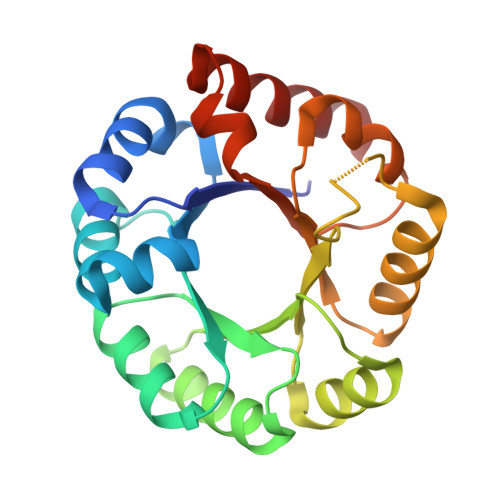Evolution of enzymatic activities in the orotidine 5'-monophosphate decarboxylase suprafamily: structural basis for catalytic promiscuity in wild-type and designed mutants of 3-keto-L-gulonate 6-phosphate decarboxylase
Wise, E.L., Yew, W.S., Akana, J., Gerlt, J.A., Rayment, I.(2005) Biochemistry 44: 1816-1823
- PubMed: 15697207
- DOI: https://doi.org/10.1021/bi0478143
- Primary Citation of Related Structures:
1XBV, 1XBX, 1XBY, 1XBZ - PubMed Abstract:
3-Keto-L-gulonate 6-phosphate decarboxylase (KGPDC) and D-arabino-hex-3-ulose 6-phosphate synthase (HPS), members of the orotidine 5'-monophosphate decarboxylase (OMPDC) suprafamily, catalyze reactions that involve the formation of Mg(2+)-ion stabilized 1,2-enediolate intermediates. The active sites of KGPDC and HPS share several conserved residues, including the presumed ligands for the Mg(2+) and a catalytic histidine residue that has been implicated in protonation of the intermediate in the KGPDC-catalyzed reaction. As reported in the previous manuscript, both enzymes are naturally promiscuous, with KGPDC from Escherichia coli catalyzing a low level of the HPS reaction and the HPS from Methylomonas aminofaciens catalyzing a significant level of the KGPDC reaction. Interestingly, the promiscuous HPS reaction catalyzed by KGPDC can be significantly enhanced by replacing no more than four active site residues from KGPDC reaction with residues from HPS. In this manuscript, we report structural studies of wild-type and mutant KDGPC's that provide a structural explanation for both the natural promiscuity for the HPS reaction and the enhanced HPS activity and diminished KGPDC activity catalyzed by active site mutants.
Organizational Affiliation:
Department of Biochemistry, University of Wisconsin, Madison, Wisconsin 53706, USA.
















